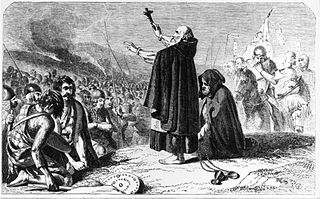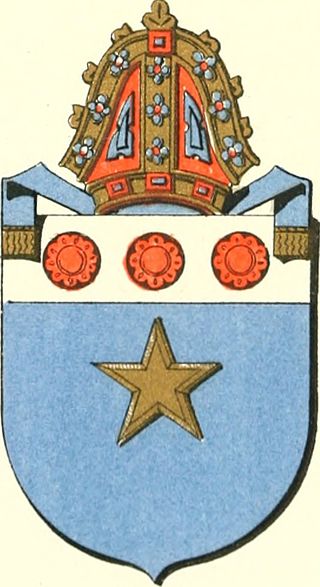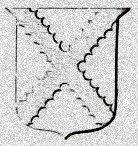
Robert Leighton was a Scottish prelate and scholar, best known as a church minister, Bishop of Dunblane, Archbishop of Glasgow, and Principal of the University of Edinburgh from 1653 to 1662. He was "noted for his Christian piety, his humility and gentleness, and his devotion to his calling".
Robert Blackadder was a medieval Scottish prelate, diplomat and politician, who was Abbot of Melrose, Bishop-elect of Aberdeen and Bishop of Glasgow; when the latter was elevated to an archbishopric in 1492, he became the first ever Archbishop of Glasgow. Blackadder died while en route to Jerusalem on pilgrimage.
Clement was a 13th-century Dominican friar who was the first member of the Dominican Order in Britain and Ireland to become a bishop. In 1233, he was selected to lead the ailing diocese of Dunblane in Scotland, and faced a struggle to bring the bishopric of Dunblane to financial viability. This involved many negotiations with the powerful religious institutions and secular authorities which had acquired control of the revenue that would normally have been the entitlement of Clement's bishopric. The negotiations proved difficult, forcing Clement to visit the papal court in Rome. While not achieving all of his aims, Clement succeeded in saving the bishopric from relocation to Inchaffray Abbey. He also regained enough revenue to begin work on the new Dunblane Cathedral.

Maurice was a 14th-century Scottish cleric who became Prior of Inchmahome, Abbot of Inchaffray and then Bishop of Dunblane. He was Prior of Inchmahome Priory in Menteith after 1297. He became abbot of Inchaffray Abbey in Strathearn between March 1304 and October 1305. As Abbot of Inchaffray, he held a canonry in the diocese of Dunblane, that is, the precentorship of Dunblane Cathedral. After the death of Nicholas de Balmyle, he was elected to the bishopric of Dunblane. He was consecrated to the see before 23 March 1322, after litigation at the Papal court. King Edward II of England had nominated one Richard de Pontefract to the see, while Roger de Ballinbreich had also been elected by the chapter; both of these men were overlooked by the Pope in Maurice's favour.

Henry le Chen [le Cheyn, le Chein, Cheyne, de Chene] was a late 13th-century and early 14th-century Scoto-Norman bishop. Hector Boece claims that he was the nephew of John III Comyn, Lord of Badenoch, but no contemporary evidence supports this. Cheyne belonged to a family with Norman roots which was well established in the northeast of Scotland, holding significant amounts of territory on the boundaries of the Earldom of Buchan.

David de Moravia was Bishop of Moray during most of the First War of Scottish Independence. He was elected Bishop of Moray, probably in early 1299. Extended details exist regarding the election because of an extant letter of Pope Boniface VIII. The result of the election was that David had 13 votes, the Dean had 4 votes, the Chancellor had 3 votes and the Archdeacon 1 vote. The Dean declared that David was elected, and sent a request for confirmation to the Papacy. The latter found an irregularity, though what exactly this was not revealed. The election result was nominally declared void, but the Pope himself provided David directly to the bishopric. He was consecrated as bishop at Anagni in Italy on 28 June 1299, by Matthew of Aquasparta, Cardinal-Bishop of Porto.
Michael Ochiltree [Ouchtre] was a 15th-century Scottish prelate and administrator. A close associate of King James I of Scotland, from the late 1410s he rose in rank from canon to Dean of Dunblane and then Bishop of Dunblane. He was responsible for the coronation of King James II of Scotland, and he obtained a grant from the crown which allowed the comparatively small diocese of Dunblane to attain historically unprecedented viability.
William Chisholm was a Scottish divine, and Bishop of Dunblane.

David Arnot was a Scottish prelate of the Catholic Church. He was the Bishop of Galloway (Scotland) from 1509 to 1526. He was from the Arnot family of Arnot, Fife.

Nicholas de Balmyle, also called Nicholas of St Andrews, was a Scottish administrator and prelate in the late 13th century and early 14th century. A graduate of an unknown university, he served his earliest years as a clergyman at St Andrews, moving on to hold churches in Lothian as well as deputising to two archdeacons of Lothian.
Andrew Magnus was a 14th-century Scottish prelate. Of unknown background, he is recorded for the first time in a document dating to 28 November 1365, holding the position of Archdeacon of Dunblane. Having merely been collated to this position by an ordinary, perhaps the Bishop of Dunblane Walter de Coventre, he received a fresh papal provision on 6 January 1367.
William de Cambuslang was a 14th-century Scottish churchman, presumably coming from a family based at or originating from Cambuslang near Glasgow.
Radulf is an obscure churchman in early 13th-century Scotland, elected as Bishop of Dunblane some time between 1223 and 1225. The first of only two notices of his existence occurs in an Arbroath Abbey deed where he is styled "Radulf elect of Dunblane"; the document can be dated to 1223–1225. On 12 January 1226 Pope Honorius III instructed the Bishop of St Andrews, the Bishop of Moray and the Bishop of Caithness, to enjoin a new election for the bishopric of Dunblane, as "R. elected Bishop of Dunblane" had resigned in the Pope's presence a short time before. There are no clues as to Radulf's career after that. The Cathedral chapter of the diocese elected one Osbert in his place. Cockburn suggested Radulf was probably a Frenchman who had immigrated to Scotland, who got elected Bishop, but decided he would rather stay in Continental Europe after he travelled there for consecration, perhaps being offered a better post there.
Walter Stewart was a 15th-century churchman in the Kingdom of Scotland. He was a cousin of King James II of Scotland, being like King James a grandson to King Robert III of Scotland.
William O. Tiron. was a late 13th-century Tironensian abbot and bishop in the Kingdom of Scotland. He appears in the extant sources for the first time on 25 April 1276; he is Abbot of Arbroath. According to the Scotichronicon, the work of the 15th-century historian Walter Bower, William's predecessor Adam de Inverlunan had died in 1275, so William probably became abbot in either that year or in 1276.
Jonathan was a churchman and prelate active in late twelfth- and early thirteenth century Strathearn, in the Kingdom of Scotland. He was the Bishop of Dunblane during the time of Gille Brigte of Strathearn, and it was during Jonathan's episcopate that Gille Brigte founded an Augustinian priory at Inchaffray.
John Herspolz or John Hepburn was Bishop of Dunblane. On the day of the resignation of the bishopric of Dunblane by Robert Lauder at the papal curia – 12 September 1466 – Pope Paul II provided Herspolz/Hepburn as Lauder's successor.
John Spalding was a 15th-century churchman based at Brechin in Angus, Scotland. Spalding became Dean of Brechin in 1456; he was confirmed in this position by the Pope on 5 October 1458.

James Chisholm, Bishop of Dunblane, was the eldest son of Edmund Chisholm, the first Chisholm to own the estate of Cromlix in Dunblane parish, Strathearn, having moved from the Scottish Borders. In his early years as a clergyman, he was a chaplain to King James III of Scotland; the king apparently sent him to Rome for some time.
Walter de Coventre was a 14th-century Scottish ecclesiastic. There is no direct evidence of his birthdate, his family, or his family's origin, although he may have come from the region around Abernethy, where a family with the name de Coventre is known to have lived. Walter appeared in the records for the first time in the 1330s, as a student at the University of Paris. From there he went on to the University of Orléans, initially as a student before becoming a lecturer there. He studied the arts, civil law and canon law, and was awarded many university degrees, including two doctorates. His studies were paid for, at least partially, by his benefices in Scotland. Despite holding perhaps more than five benefices at one stage, he did not return to Scotland until the late 1350s.






